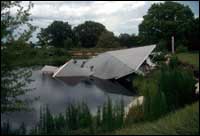|
 |
|
 |
 |
| Physical Agents of Land Loss: |
|
|
 |
|
 |
|
 |
|
|
 |
|
 |
|
 |
 |
| Role of Shoreline Characteristics: |
|
 |
| Composition, Induration, & Saturation |
 |
|
 |
|
|
 |
|
 |
 |
| Role of Human Activities: |
|
 |
|
 |
|
 |
|
 |
|
 |
|
 |
|
 |
|
|
 |
|
 |
|
 |
|
 |
|
|
 |
Role of Shoreline Characteristics: Composition, Induration, & Saturation
 |
| Figure 9. Collapse of sinkholes in limestone terrane causes catastrophic land loss. [larger version] |
Lithologic composition and hardness determine the land loss potential of the coast. For example, loose sand is more easily eroded than compacted, stiff mud. Hard crystalline rocks resist erosion and consequently some rocky coastlines in New England and along the Pacific coast have not changed appreciably in recorded history (Shepard and Wanless, 1971; Bird and Schwartz, 1985). Some limestones such as the coral reefs of the Florida Keys also resist erosion, but other limestones may be dissolved by underground springs that cause the land to collapse and form drowned sinkholes (Fig. 9). Some land loss along the west Florida coast near Homosassa Springs is caused by nearsurface dissolution of limestone, or karst terrane (Davis et al., 1985). These karst features are only sparsely developed and therefore no major structural damage is reported. However, these same areas would fail catastrophically like other densely developed sinkhole terranes such as near Orlando, Florida where schools and car lots have been destroyed as sinkholes collapsed.
Even height of the water table can influence the erodability of sandy beaches. The beach is less susceptible to erosion when the water level in the beach is lower than the ocean. As waves run up an unsaturated beach, the water flows into the sand. This causes deposition of sand carried by the waves and reduces the backflow of water returning to the ocean. Conversely, erosion is enhanced when the beach sand is saturated and the water level in the beach is higher than the ocean. When this happens, water flowing out of the beach and down the beach face carries sand with it and makes the beach more susceptible to erosion.
continue to Coastal Morphology & Vegetation
 |



